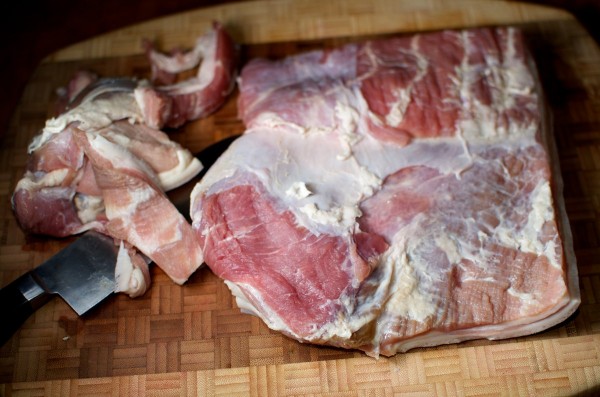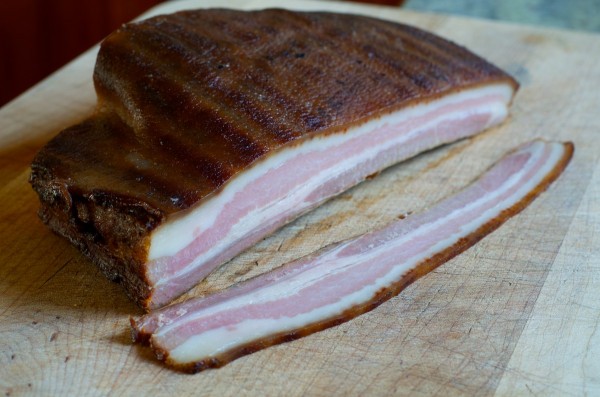Let’s not kill anyone, shall we? Always a fine goal when making any tasty treat. The risk with this recipe is higher than most, (primarily because of botulism) so keep that in mind, along with the fact that I’m not a professional, and basically don’t know what the hell I’m talking about. There. If that didn’t scare you off, then you must be my kind of people. Now let’s make some delicious bacon, without the (allegedly) terrifyingly unhealthy nitrates and nitrites!
UPDATE: Nitrates and Nitrites probably not bad for you. I’ve left the recipe as is, but noted how you could add nitrite if you wish. For what it is worth, I usually do use nitrates these days.
UPDATE 2: People! I’m getting a lot of push-back in the comments about the safety of this no-nitrates recipe. People talking about botulism and other terrors. If you follow my recipe, you don’t need to worry about food safety. Â Here is how I convince myself that it is safe: Is there anything in this recipe that someone wouldn’t happily do when smoking a pork shoulder or bbq ribs? Holding a piece of meat in a properly cool fridge for 5-7 days is no problem. Smoking a piece of meat for 2-3 hours is no problem. Just because it is “cured” and we call it bacon, doesn’t make it magically dangerous. Critics, if it makes you feel better, don’t call it bacon. Call it “salty-smoked pork belly”. Feel better?
My bacon is different than bacon you can buy at the store, and not just because it doesn’t have nitrates. (BTW, that “uncured” bacon you’ve been buying at the grocery store? Packed with nitrates.) Since we are using salt, sugar, and smoke as actual preservatives, rather than just flavorings, this bacon is much more intensely flavored that modern bacon. Since we are dry curing, the bacon loses water in the process, which concentrates and intensifies flavors compared to store bacon, which often has brine added to it to make it heavier! The upshot is that this bacon tastes more salty, more smoky, more intense, more “bacony”, and since it has less water in it, doesn’t spatter, pop, and curl as much during cooking either! Let’s cure some bacon!
But first, some debunking. Most people think of  nitrates and nitrites as modern preservatives of today’s unhealthy processed food. In fact, nitrates have been added to bacon and ham as part of the curing process since at least the 16th century. Back then, it was added in the form of “saltpeter” which is potassium nitrate that has been sweated out by rocks, and crystalized on the surface. Saltpeter is mostly potassium nitrate, but some of it is transformed during the cure to nitrite, which is the real preservative agent. On top of that, nitrates and nitrites preserve the pink color of the meat, and slow oxidation of fats, which prevents the meat from becoming rancid. So why not use this amazing stuff that improves shelf life, reduces the risk of botulism, preserves color, and slows oxidation (rancidity)? Well, a lot of people think they are completely horrible for our health, and some people think they taste bad. Simple as that. Personally, I’m not scared of a few nitrates, nitrates occur naturally in some leafy greens, in celery, and in our saliva, and they. But you still don’t want nitrates!  Luckily there is an established tradition of curing meat with salt and smoke which uses no nitrates, and that is what we shall do.
So. What the hell is a preservative? A preservative is basically anything that makes your food less tasty and hospitable to microbes. Nitrates and nitrates basically poison bacteria that would otherwise grow on the meat. Another method is to smoke the meat, which deposits a layer of compounds on the meat which inhibit bacterial growth, and incidentally, taste yummy. Another, very important method is to reduce the moisture in the meat, since bacteria need moisture to grow. This can be done by dehydration, as in jerky. Or we can draw moisture out of the meat by creating an osmotic gradient using  salt and/or sugar. We will use salt, sugar, smoke, and time to cure our bacon.
Let me take a moment to bitch about modern “bacon”. They inject a brine of salt, sugar, nitrates, nitrites, some smoke flavor, and who knows what else into pork bellies with hundreds of tiny needles. They let it “cure” for a couple of hours, and then package it up. That is that, enough said.
Dry Cured Bacon
With Advice from Uncle Hall and the great book Charcuterie by Ruhlman & Polcyn
Cut a pork belly into manageable chunks of around 3-5 lb, trimmed of loose bits, and squared it off. Make a mixture of (by weight) of 2.5 parts salt (kosher adheres very nicely), 1 part sugar, then add a generous grind of black pepper. If you are using pink salt (aka curing salt which is 6.25% nitrite), add 7 tsp per lb of your cure mixture. Rub the mixture thoroughly all over the belly, working it firmly onto every surface and crevice. You really want to coat every surface very thickly, or else the salt may not draw enough moisture from the meat.
Put the proto-bacon on a rack, into the fridge. A quick safety note; you must keep your bacon under 38º the entire cure! It will release a lot of juice, which is good, this type of curing depends on reducing the moisture of the meat. After a couple of days (at most), it will stop releasing juices, and for convenience, you can throw it in a ziploc bag, with a sprinkling of additional cure mixture, and leave it in the fridge for another 5-7days. At the end of the week, give it a thorough rub down in fresh water, even letting it soak for a few minutes in fresh water, then pat it dry. Let it sit uncovered in the fridge one more night to let the surface dry a bit, which will help it form a pellicle. A pellicle is simply a coating of protein that comes to the surface and dries out a bit. Allegedly, this helps smoke adhere better, and improves shelf life by keeping oxygen away from the fat. YMMV.
I do my smoking, grilling and BBQ in my beloved Primo ceramic grill, but honestly, any grill or smoker skillfully handled will work fine.  Get a small fire going in your grill/BBQ, far to one side of the grill. Get the temperature of the grill stabilized around 200º. Sprinkle some soaked hickory chips over the coals, and then also put a foil packet of soaked chips (with a few holes poked in the top) on top of the coals. On the extreme opposite side of the grill lay out your pork belly, then put the lid on the BBQ, positioning the holes in the lid over the belly. Keep monitoring the temp of the grill, and let it smoke for 2-3 hours, removing it when the temperature of the meat reaches 155-165º. You may have to adjust the fire, add a few more coals, more chips, another foil packet, etc. Do what you have to do to keep it producing smoke, and the temperature around 200º.
Once smoked, remove the bacon, and optionally, remove the skin before letting it cool on a rack. The skin cooks up a little tougher and crunchier than the rest of the bacon, some people like it, some don’t. I leave it on. If you don’t want the skin, it pulls off reasonably well while the bacon is still warm, or you can use a thin bladed knife to carve the skin off the slab. Refrigerate, or freeze if you want to keep it for more than a few days. Technically, it is cured, and should keep very well, but freezing doesn’t hurt the bacon, and it is better to be safe than sorry.
To cook the bacon, slice the bacon very, very thinly, which is necessary because this bacon is saltier and more intense than what you are likely used to. Cook it it a pan, appreciating how readily it browns, and without all the popping, curling, and carrying on that wet-cured factory bacon does. Enjoy!






129 Comments